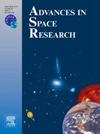Method of generating potential evapotranspiration with high precision and resolution
IF 2.8
3区 地球科学
Q2 ASTRONOMY & ASTROPHYSICS
引用次数: 0
Abstract
Potential evapotranspiration (PET) is a key factor in hydrological cycle and energy balance and plays an important role in drought and global climate change response. Existing observational and modeling methods for PET retrieval have their limitations, such as low precision and poor spatial resolution, which becomes the focus of this study. A hybrid PET fusion (HPF) method is proposed by fusing station- and grid-based PET, in which the PET expression is determined by considering the factors of location, temperature, and zenith total delay (ZTD). In addition, an improved Helmert variance component estimation method is introduced to determine the optimal weights of the HPF model. Corresponding data, which include monthly Thornthwaite (TH)-derived PET data with a spatial resolution of 0.25° × 0.25° and Penman–Monteith (PM)-derived PET data at 704 meteorological stations, over the past 60 years from 1959 to 2018 in China are selected. The 10-fold cross-validation method is introduced to evaluate the internal and external accuracies of the proposed HPF method. Statistical result shows that the average root mean square (RMS) of the proposed HPF method is 13.98 mm, with an average RMS improvement rate (IR) of 46.71 % compared with TH-derived PET, when PM-derived PET is regarded as a reference. Moreover, the performance of the HPF-derived standardized precipitation evapotranspiration index (SPEI) is evaluated at different time scales, and the average RMS is 0.3, with an average RMS IR of 26.33 % compared with TH-derived SPEI. Such results verify the good performance of the proposed HPF model and enrich the methods for obtaining PET with high precision and resolution.
求助全文
约1分钟内获得全文
求助全文
来源期刊

Advances in Space Research
地学天文-地球科学综合
CiteScore
5.20
自引率
11.50%
发文量
800
审稿时长
5.8 months
期刊介绍:
The COSPAR publication Advances in Space Research (ASR) is an open journal covering all areas of space research including: space studies of the Earth''s surface, meteorology, climate, the Earth-Moon system, planets and small bodies of the solar system, upper atmospheres, ionospheres and magnetospheres of the Earth and planets including reference atmospheres, space plasmas in the solar system, astrophysics from space, materials sciences in space, fundamental physics in space, space debris, space weather, Earth observations of space phenomena, etc.
NB: Please note that manuscripts related to life sciences as related to space are no more accepted for submission to Advances in Space Research. Such manuscripts should now be submitted to the new COSPAR Journal Life Sciences in Space Research (LSSR).
All submissions are reviewed by two scientists in the field. COSPAR is an interdisciplinary scientific organization concerned with the progress of space research on an international scale. Operating under the rules of ICSU, COSPAR ignores political considerations and considers all questions solely from the scientific viewpoint.
 求助内容:
求助内容: 应助结果提醒方式:
应助结果提醒方式:


